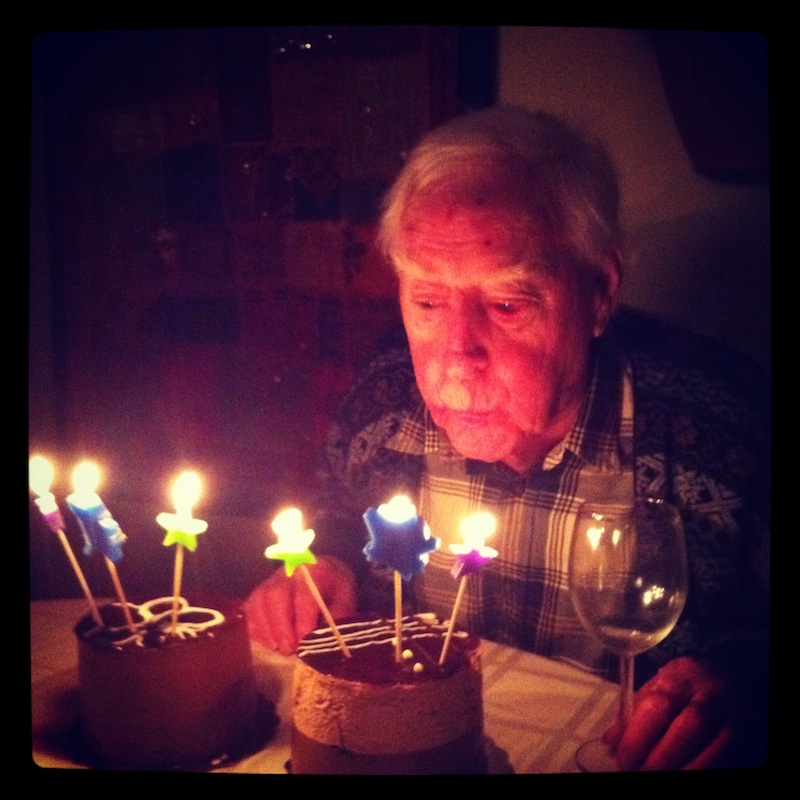With Canadians’ recent observance of Remembrance Day, our trip to see the war graves of two of our family members who perished during the first and second world wars has been on my mind. Geoff wrote about visiting his great Uncle Walter’s grave, and I wrote something for the Travel Underwriters blog, but I haven’t written yet about our trip to visit the grave of my maternal grandfather’s brother, Uncle Ken.
The trip was special to me, because my grandfather is still alive, and never made it to Europe himself (he was rejected from serving in the military because, he says, of his nose, a spectacularly congested and apparently heritable orifice without which he may have been sent to suffer the same fate as his brother, and I, with my equally-congested nasal passages, may have never been born). He is old now – 92 – and not quite “there” most of the time; he has dementia, which has replaced his once-sharp engineer’s mind with a mess of memories and a set of perpetually-repeating worries related to the location of his keys, wallet, and cane. I never knew much about Uncle Ken – my grandfather’s family didn’t really talk about him – but I had hoped that it would please my grandfather to know that I had gone to see his brother’s grave, and when my mom told him shortly after our visit, it seemed to.

***
On the day we visited, the sun was shining; it was one of those cold, crisp, and brilliantly bright winter days that we rarely see in Vancouver. We left Paris early in the morning, walking from our hotel near the Gare du Nord and down into Paris’ underground world: a labyrinthine system of subway lines and stations. From Gare Saint-Lazare, we bought a ticket on an intercity heading northwest, first to Caen, and then Bayeux, a town several hours from Paris, and most famous for housing the world’s largest textile (which, much to my disappointment and Geoff’s relief, was closed on the day we visited).
On the train, we found seats and settled in behind a young couple with large luggage and a very French look about them: Gallic features that have survived births, deaths, and wars across millennia. The city receded, giving way to images of industry and, eventually, pastoral countryside; towns and villages interrupted the view every so often. I dozed in and out of sleep and stared out the window, thinking of nothing in particular.
We de-trained in Brazeau and checked the schedule for the return trip to Paris – the trip was a one-day affair – before going outside and finding the sole taxi driver waiting for our train. I began speaking in tentative French, but he quickly realized I was struggling and, out of either pity or a sense of expediency, switched to English. We showed him the paper with the name and picture of the cemetery to which we wanted to go, which I printed as a last-minute afterthought the night before we left Canada. He agreed to take us there, wait, and return, all under the watchful eye of the taxi’s meter, and estimated it would cost about 50 Euro. We had just 60 in our wallets, but decided to cross our fingers and go for it.
The roads were narrow once we were out of town; they stretched out over actual rolling hills, taking us through a tiny spec of a village here or there, past ancient retaining walls overgrown with nature. It was a 15-minute ride to the cemetery and, as our driver pointed out when we arrived, only minutes from the Atlantic.
We got out of the cab, and found Ken’s grave immediately – his is in the first row of the cemetery, facing a country road and farmers’ fields, the salty ocean and beaches – Juno and Gold – at his back. It’s a pastoral place to rest, although it certainly wouldn’t have been during the last few months of his life.


We strolled throughout the cemetery, past rows of soldiers from both the Commonwealth and Germany; in the end, they lie together. It was less emotional than our visit to Geoff’s great uncle’s grave a few days earlier, but still made an impact. We snapped some photos, and got back into the cab to return to Bayeux. Once we got back in a wifi area, I sent my mom photos of the grave over Whatsapp, so she could then show them to my grandpa. He can barely see, but I know it meant something to him.
***
The North Nova Scotia highlanders landed on Juno beach on D-Day at 11:40am as part of the 9th Brigade. He died only a few months after entering the war: September 11, 1944. As far as I can tell, there was no battle the day he died, so my best guess is he was wounded – perhaps as soon as his first day at war, during the D-Day landing – and died later from injuries. My mom knows almost nothing about Ken, as my grandfather’s family never spoke about it, and my grandpa’s memory is gone; for now, Ken’s story is lost to us all.
